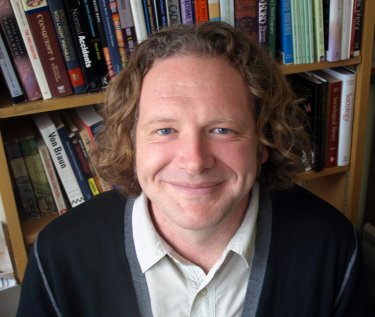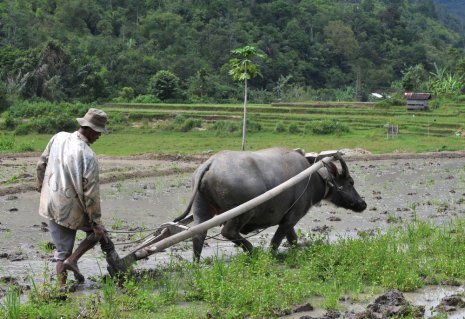EUGENE, Ore. — (April 9, 2013) — Animals have helped sculpt human societies throughout history, but they are not getting proper credit for their influence, says University of Oregon sociologist Richard York. York and fellow sociologist Philip Mancus of the College of the Redwoods in Crescent City, Calif., make that argument in a paper published in the current issue of the quarterly journal Sociological Theory. They say that animals are more than pets or domesticated creatures bended to human needs. Instead, animals have had "profound influence" in driving the evolution of human societies.
York and fellow sociologist Philip Mancus of the College of the Redwoods in Crescent City, Calif., make that argument in a paper published in the current issue of the quarterly journal Sociological Theory. They say that animals are more than pets or domesticated creatures bended to human needs. Instead, animals have had "profound influence" in driving the evolution of human societies.
That idea has been slowly emerging in sociology, which focuses on the origin, development, organization and functioning of human society. In 2002, the American Sociological Association created the section "Animals & Society" as a response to new interest in the relationships of humans and non-human animals. York is a member. Last year, the book "Animals and Sociology" by Kay Peggs, a lecturer in sociology at the University of Portsmouth in England, summarized past approaches used to study animals' contributions and how that research had marginalized them.
The new paper "The Invisible Animal: Anthrozoology and Macrosociology" is, "to an extent, a call to action" to seriously advance such research, York said.
In making their case, York and Mancus, who received a doctorate in sociology in 2009 from the UO, reviewed the "Ecological-Evolutionary Theory" introduced in 1966 by Gerhard Lenski. His 1970 textbook "Human Societies: A Macrolevel Introduction to Sociology" was used for several years to introduce students to sociology. The new paper cites a limitation of Lenski's theory: the tendency to ignore the influence of animals on the evolution of societies while focusing instead on how technology and economics have driven sociocultural evolution.
"It was our effort to suggest that sociologists and other social scientists should give greater consideration to how animals affect societies," York said. "In the past few years, there have been a slowly growing number of studies addressing animal-human connections, but most of these in sociology are either focused on a micro-level of human relationships with animal companions or focused on the symbolic meaning people ascribe to animals. Our effort was to show that animals influence the historical development of societies, and that the actual characteristics of animals, not just the meaning humans make of them, matter." In a section of their new paper, the authors address those characteristics, asking the question: "Who Made Whom?" They argue that animals are complex creatures, not just "putty that humans sculpted to fit their needs" as seen in the traditional view that says localized cultural factors alone drove human efforts to make use of them and export them to new lands.
In a section of their new paper, the authors address those characteristics, asking the question: "Who Made Whom?" They argue that animals are complex creatures, not just "putty that humans sculpted to fit their needs" as seen in the traditional view that says localized cultural factors alone drove human efforts to make use of them and export them to new lands.
Just five of 14 species of large animals domesticated before the 20th century — the cow, sheep, goat, pig and horse — became widespread and important around the world. More domestication was tried but failed, the authors noted, at least in part, because of the nature of the animals involved.
York and Mancus also took issue with Lenski's heavy emphasis on the role of the plow, rather than the animals that pull it, in driving technological advances. Plows are only useful when combined with draft animals such as horses and oxen. Thus, a major difference between the Old World and New World was that the former had large draft animals and the latter — with only small animals such as the llama, alpaca, guinea pig, and dog — did not. The Incas, for example, instead devised the taclla, a human-powered digging stick that also served as a hoe.
The use of the horse and elephant in warfare also serves as an example of societies' making use of local-origin animals. Hannibal deployed elephants against the Romans, and Spanish conquistadors were aided by their mastery of the horse in bringing down the Aztec and Incan empires.
"Not only does the social construction of animals affect their fate," wrote the authors in reference to work by Lenski, now professor emeritus at the University of North Carolina at Chapel Hill, and other scholars who have addressed human-animal interactions, "but also the material properties of animals affect ours, conditioning the social being and the consciousness of a people."
The importance of particular traits in animals and how they are interpreted, noted York and Mancus, "is influenced by the social utility of such traits." Sociological theory, they concluded, can be improved by recognizing the role of animals in human societies and enrich the field "by adding new ideas to old debates and opening up new debates in turn."
About the University of Oregon
The University of Oregon is among the 108 institutions chosen from 4,633 U.S. universities for top-tier designation of "Very High Research Activity" in the 2010 Carnegie Classification of Institutions of Higher Education. The UO also is one of two Pacific Northwest members of the Association of American Universities.
Media Contact: Jim Barlow, director of science and research communications, 541-346-3481, jebarlow@uoregon.edu
Source: Richard York, professor of sociology and environmental studies, 541-346-5064, rfyork@uoregon.edu
Other Links:
Follow UO Science on Facebook: http://www.facebook.com/UniversityOfOregonScience
UO Science on Twitter: http://twitter.com/UO_Research
More UO Science/Research News: http://uoresearch.uoregon.edu
Note: The University of Oregon is equipped with an on-campus television studio with satellite uplink capacity, and a radio studio with an ISDN phone line for broadcast-quality radio interviews. Call the Media Contact above to begin the process.
Media Relations